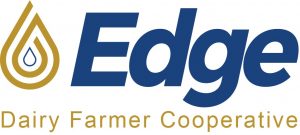
On November 12, USDA Agricultural Marketing Service (AMS) released a long-awaited final decision with reforms to pricing formulas used by the Federal Milk Marketing Order system. Edge Dairy Farmer Cooperative appreciates the diligent work of AMS staff put forth the milk pricing reform.
 |
“While not all of our proposals were included in the final decision, and we believe more could have been done to enhance the pricing formula, we are satisfied that the changes do not negatively impact our dairy farmer members,” Tim Trotter, Edge CEO said. “In aggregate, we believe the proposed reform would slightly decrease the minimum regulated price private milk buyers have to pay to pooled milk producers in the Upper Midwest order and would slightly increase the price to producers in the Central and Mideast orders. In all cases, we expect the impact on milk checks, after accounting for impact to over-order premiums, to be neutral or positive.”
The final version released does not deviate from the proposed decision released in July. The reform highlights of interest to our members in the Upper Midwest include:
- Update milk composition factors: true protein from 3.1 to 3.3 percent, and other solids from 5.9 to 6 percent. This change is expected to slightly increase revenue from sales of beverage (Class I) milk to pooled producers. AMS decided not to update butterfat solids, despite rapid growth in butterfat content of milk in recent years. Edge has cautioned AMS and the industry that updating skim milk factors without corresponding increase in butterfat factor will complicate dairy producers hedging programs. Without this important addition, a producer hedging with Class III milk futures or equivalent USDA insurance products may be more exposed to butterfat price risk.
- Removal of 500-pound barrel cheddar cheese from the Dairy Products Mandatory Reporting Program survey. Industry advocates of this removal believe relying solely on 40-pound block cheddar cheese to set the monthly announced cheese price will reduce market distortions and enhance the announced protein price. In its testimony Edge cautioned the industry and the AMS that removing barrels at a time when new cheddar cheese processing capacity is entirely oriented to block cheese risks reducing, rather than enhancing Class III milk price.
- Update the manufacturing allowances: Cheese: from $0.2003 to $0.2519; Butter: from $0.1715 to $0.2272; Nonfat Dry Milk (NFDM): from $0.1678 to $0.2393; and Dry Whey: from $0.1991 to $0.2668. This decision also proposes updating the butterfat recovery factor to 91 percent. The combined direct effect of these changes will be a reduction of Class III price by -$0.91/cwt and of Class IV price by -$0.85/cwt. Edge has consistently advocated for delay in make allowances reform, until costs of processing surveys with mandatory participation can be conducted. Edge has further advocated that make allowances should be based on the cost profile of plants at the technological frontier, rather than passing higher processing costs in older, inefficient cheese plants to dairy farmers.
- The base Class I skim milk price would once again be based on the higher-of the advanced Class III or Class IV skim milk prices for the month. A notable and commendable exception is the introduction of a Class I extended shelf life (ESL) adjustment which would in practice allow ESL milk to continue to be priced under the average-of regime, with a 24-month rolling average adjuster with a 12-month lag. In designing the ESL adjuster, AMS opted for a solution that closely mimics the idea brainstormed by Edge during the hearing, which for procedural reasons was not included in the hearing record. Edge commends AMS for recognizing the importance of risk management as a core consideration in the design of FMMO rules. Edge believes this decision will accelerate innovation in the beverage milk sector and offer further opportunities for Midwest/Mideast dairy producers to serve fluid milk markets across the nation.
- Class I and Class II differentials. Keep the $1.60 base differential and adopt modified location specific Class I differential values. The primary purpose of Class I differentials is to encourage the transportation of beverage milk from surplus to deficit areas. This decision increases the spread between the differentials in the Midwest/Mideast region and the eastern/southeastern U.S., providing additional incentives and opportunities for milk producers in the Midwest/Mideast region to serve deficit coastal markets.
The draft of the final decision is available here.
Following the publication of the final decision in the Federal Register, AMS will conduct producer referendums in each of the 11 FMMOs. Producers whose milk was pooled on an FMMO in January 2024 are eligible to participate in the referendum. AMS will mail ballots to eligible independent producers and qualified cooperative associations. Ballots must be postmarked by Dec. 31, 2024, and returned by Jan. 15, 2025, to be counted. If at least two-thirds of the producers or two-thirds of the milk represented in the vote approve of an amended order, AMS will issue a final rule implementing the changes.
Unlike most producers who are members of manufacturing cooperatives, Edge producers who were pooled in January 2024 will have the privilege to decide individually whether to vote to approve or disapprove proposed changes. In making that decision, they should be aware that the decision to disapprove the proposed reforms is a vote to completely eliminate their Federal Milk Marketing Order.
“It is important for farmers to know that a vote to disapprove of this ruling is a vote to end the FMMO in that region,” Trotter said. “While we believe more could have been done to improve the milk pricing, we still believe it is still better to have the FMMO and the protections it brings for producers and as such encourage a yes vote on the final rule.”
You can now read the most important #news on #eDairyNews #Whatsapp channels!!!
🇺🇸 eDairy News INGLÊS: https://whatsapp.com/channel/0029VaKsjzGDTkJyIN6hcP1K























